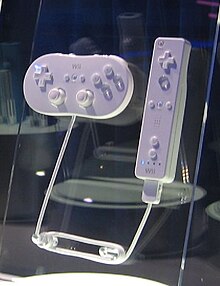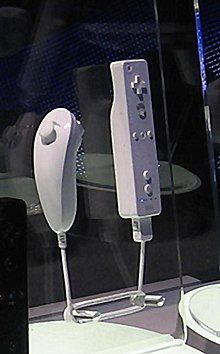Wii remote control

The Wii remote control (official name: Wii Remote or shortened Wiimote [ wi: ɪ'məʊt ], from "remote control" for "remote control") is the primary game controller for the 2006 released game console Wii . It is also compatible with the Wii U released in 2012 . It represents a big difference between the Wii console and the systems of the market competitors ( PlayStation 3 and Xbox 360 ): While their console systems are equipped with classic controllers and designed for conventional games, the Wii Remote is supposed to enable games that focus on arm movements can be operated in free space and thus realize a more intuitive control. The predecessor of the Wii Remote is the Nintendo GameCube controller of the Nintendo GameCube , the successor to the Wii Remote is the Wii U GamePad or the Wii U Pro Controller . With the Wii Motion Plus , a revised version of the Wii remote control appeared in 2009.
Controls
With the help of two reference points in the sensor bar , which is placed below or above the TV screen, and an infrared camera on the front of the Wiimote, which detects up to four infrared sources, the position of the controller relative to the TV can be determined. This makes it possible to target game objects directly on the screen. The precision is comparable to that of a mouse pointer on graphical user interfaces.
In addition, the controller contains an acceleration sensor with which movements and rotations of the controller can be recorded and used directly for game control. The game "Wii Sports: Tennis", with which the technique was demonstrated, allows for example overhead serves, forehand, backhand, topspin, etc. by the player performing the movements as if he had a tennis racket in hand. In other games such as Red Steel, for example, the player swings the controller like a sword in order to have the character perform a comparable action.
Other elements are:
- two large buttons: the 'A' on the top and the trigger- shaped 'B' button on the bottom
- a digital control pad above 'A'
- two buttons '1' and '2' at the bottom of the remote control
- three small buttons next to each other on the middle of the Wiimote: '+' ("Plus"), '-' ("Minus") and "Home".
Others
The Wii remote control was originally developed for the Nintendo GameCube, as it did not sell particularly well compared to the competition. For this reason, Nintendo planned a hardware add-on in a remote control-like form. In fact, there was already a design back then that could be a 1: 1 copy of the Wii Remote.
A horizontally held Wii-FB can be used as a gamepad if the game allows it.
Communication with the console is wireless via Bluetooth . The maximum distance is 10 meters. If the Wii-FB is used to aim at the screen (menu navigation or when playing), the distance is reduced to 5 meters.
For additional, mechanical feedback to the player (rumble), the Wii remote control can generate vibration effects.
The Wii-FB also has a built-in loudspeaker.
An internal memory allows the storage of user profiles, for example to define the sensitivity or the inversion of the Y-axis. In addition, game avatars (so-called Mii) that you have created yourself can be saved, for example to take the tennis player from home to friends and play with him there.
Extensions
The controller can be expanded using a plug contact on the bottom. With the second (initially free) hand, the player can operate additional controls. Currently available are:
- Nunchuk controller: an analog stick with its own motion sensor
- Wii Classic Controller , a regular gamepad
- Wii Classic Controller Pro , an upgrade of the Wii Classic Controller with additional handles for a better feel
- Guitar for the Guitar Hero series
- Wii MotionPlus , a plug-in attachment that refines the movement and position determination of the remote control.
Vitality sensor
The Vitality Sensor was a heart rate monitor that was supposed to analyze the physical situation. For example, the level of difficulty of the game could have been calculated directly from the console and also adapted to the physical condition. In 2013, however, Satoru Iwata announced at a shareholders' conference that the Vitality Sensor project had been canceled because the device only worked correctly for 90 out of 100 people. If, however, one day the technology is so advanced that the sensor works correctly in 999 out of 1000 people, one is not averse to resuming the project.
Wii Motion Plus
The Wii Motion Plus has been shipped with various games since mid-2009, including the Wii Sports Resort game . You can also purchase Motion Plus individually. This is a small plug with a built-in gyroscope that is connected to the bottom of the Wiimote. There is also a connection socket on the accessory, so that additional devices such as the Nunchuk can be connected.
Motion Plus makes it possible to determine the movement and position of the Wiimote even better and to precisely record even the smallest movements. This only works with games that support Wii Motion Plus, older games do not benefit from the expansion.
In the future, all new games that require the most precise control possible will support this additional device.
The Wii Remote Plus , a new remote control that combines the classic Wiimote and Wii Motion Plus, has been on sale in Germany since November 5, 2010 .
Nunchuk
The Nunchuk is an extension of the Wii Remote. It has an analog stick , two keys labeled C and Z and acceleration sensors that register the movements of the nunchuk and convert them for the console. A Nunchuk controller comes standard with every Wii console. The name "Nunchuk" is based on the East Asian striking weapon nunchaku .
Other uses
Johnny Chung Lee showed another way to use the controller at TED in February 2008 . He uses a Wiimote to determine positions with the help of the infrared camera. With the Wii, the infrared light source is permanently installed and the Wiimote (the IR camera) is moved. Johnny Chung Lee now reverses the functions - the camera is fixed and the IR light source moves. If an image is projected onto a flat surface with the help of a projector, the position of the pen can be determined with an infrared pen. This now acts as a mouse pointer . This makes it easy to create an inexpensive replacement for an interactive whiteboard . The position in three-dimensional space can be determined with two infrared sources . With two infrared LEDs , positions in three-dimensional space can be transferred to the computer, which Johnny Chung Lee calls "head tracking".
In October 2007, two students created driver software that enables the Wiimote to be connected to a Symbian OS smartphone via Bluetooth. This is usually not possible because the Wiimote's design requires a special HID protocol for game controllers . The driver software "places" the buttons and sensor data of the Wiimote on similar buttons on the smartphone so that it can be completely remote-controlled with the Wiimote. The LEDs and the vibration unit of the Wiimote can also be addressed from the smartphone. The integrated loudspeaker and the infrared camera are not supported. The Wiimote data is also offered on an internal program interface in the smartphone and can thus be used by other software developers. The project shows that the boundaries between technologies are becoming increasingly blurred and that a smartphone can (to a limited extent) replace the Wii console. It was shown at the Symbian Smartphone Show London 2007 and at the FMK Forum Mobilkommunikation 2007 with a demo game that uses the Wiimote's acceleration sensor.
There are several programs and drivers with which the signals from the Wiimote can be transferred to the PC.
The extensions of the Wiimote (as well as the internal IR sensor) are based on the I²C bus. It is thus possible to control the Classic Controller, the Nunchuk or the Wii Motion Plus with I²C compatible hardware such as the Arduino board.
Using the appropriate adapter, it is also possible to operate the Nunchuk or the Classic Controller on older Nintendo consoles, e.g. the SNES and NES .
At the 2009 German Judo Individual Championship , the Wiimote was tested to support the judges. However, evaluating this method was considered imprecise and commented as a "one-time attempt".
equipment
Case and colors
The Wii Remote can always be purchased with a case and wrist strap. It is available in different versions:
- black
- White
- blue
- red
- gold (included in the Limited Edition of The Legend Of Zelda: Skyward Sword )
- red (in Mario design)
- green (in Luigi design)
- light green (in Yoshi design)
- pink (in peach design)
- orange (in Bowser design)
- white (in Toad design)
Charging station
The Wii Remote is usually supplied with 2 AA batteries . Nintendo and third-party suppliers also have sets with a charging station and batteries .
Individual evidence
- ↑ Wiimote was originally developed for the GameCube
- ↑ Presentation of the Wii Vitality Sensor
- ↑ http://www.nintendo-online.de/wii/news/12305/aus-die-maus-das-schicksal-des-wii-vitality-sensors/
- ↑ Games with Motion Plus support
- ↑ Wii Remote Control Plus (RemotePlus): The date is fixed , on Computerbild.de from October 15, 2010.
- ↑ "An interactive whiteboard for 50 euros"
- ↑ "Johnny Chung Lee Wii Projects"
- ↑ "The mobiPad project" ( Memento of the original from August 1, 2008 in the Internet Archive ) Info: The archive link was inserted automatically and has not yet been checked. Please check the original and archive link according to the instructions and then remove this notice.
- ↑ Golem.de: "Controlling Symbian mobile games via Wii remote control"
- ↑ "Wii-Nunchuk as a universal control" ( Memento of the original from February 23, 2010 in the Internet Archive ) Info: The archive link was automatically inserted and not yet checked. Please check the original and archive link according to the instructions and then remove this notice.
- ↑ "Nunchuk 2 SNES Interface"
- ↑ Ruhr Nachrichten: "But no Wii console for judges" ( Memento of the original from March 15, 2010 in the Internet Archive ) Info: The archive link was automatically inserted and not yet checked. Please check the original and archive link according to the instructions and then remove this notice.






